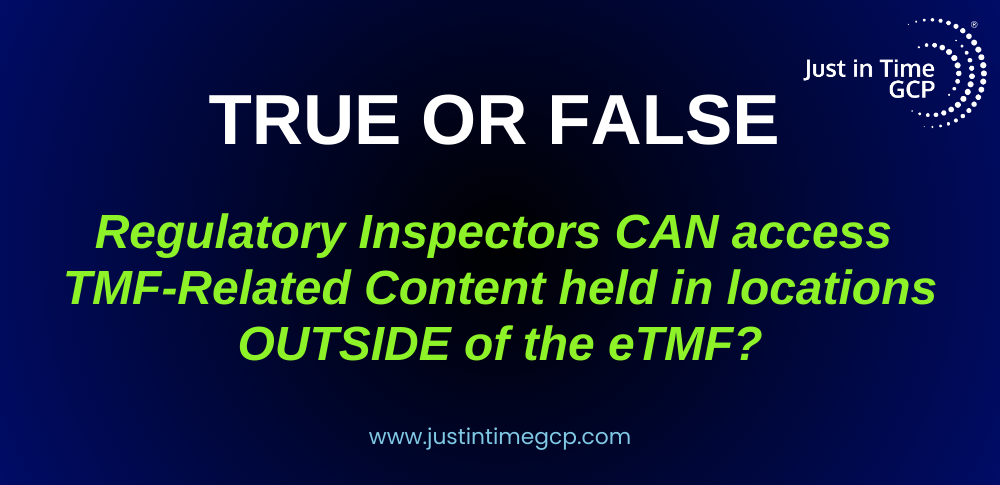
Hidden TMF Clinical Compliance Risks
The Risk Of Inspectable Content Housed Outside the TMF
In the fast-paced world of clinical trial compliance, maintaining a robust and compliant Trial Master File (TMF) is essential for inspection readiness clinical trials. Yet, many sponsors inadvertently overlook critical good clinical practice (GCP) documentation. This oversight can create unnecessary stress and risk for organizations.
The TMF is defined as the collection of records that show that the trial is being conducted with good clinical practice guidelines and regulatory requirements. This system consists of multiple components where essential content is stored. The electronic TMF (eTMF) is a content management system specifically configured and validated to support the organization and retrieval of these records. Here, we explore the challenges sponsors face with TMF content management and provide insights into effective solutions.
The Overlooked TMF Content Problem
Sponsors often outsource TMF management responsibilities to Clinical Research Organizations (CROs). Assuming the TMF is fully maintained. However, sponsors retain responsibility for generating essential clinical research compliance documentation, including: Vendor oversight records, internal decision making logs, communications regarding trial processes.
A significant portion of these documents often reside outside the electronic trial master file typically stored in emails, shared drives, or unvalidated Share Point sites. This disorganization poses challenges during clinical trial inspection readiness services reviews.
Why TMF Storage Matters
Regulatory authorities, including the FDA, MHRA, and EMA, consider all TMF content inspectable. This includes not only the records in the official eTMF system but also any records that support the sponsor’s oversight activities that may be held in other systems. Failure to appropriately manage and maintain these records in a validated system can lead to inspection findings, delayed approvals, or reputational damage.
What’s the Worst that Could Happen?
- Non-compliance with regulatory requirements: Shared drives and unvalidated systems like SharePoint often lack the necessary controls for electronic record management, such as audit trails and access restrictions.
- Disorganization during inspections: Critical content scattered across multiple systems creates delays and inconsistencies when trying to respond to inspector requests.
- Compromised data integrity: Without proper metadata assignment or validation, records can lose their context and traceability.
Ensuring your TMF is in a Validated System
One prevalent misconception is that storing content in SharePoint meets good clinical practice (GCP) compliance standards. While these platforms may offer convenience, they typically do not meet regulatory requirements for maintaining electronic records. For example, they often lack:
- Validation to ensure the system operates as intended.
- Audit trails to track who accessed or modified a document.
- Secure access controls to protect sensitive information.
- The ability to easily retrieve a record during the inspection
- The ability to give the inspector direct access to the record
Regulators expect sponsors to use validated systems for managing trial records. Content stored in non-compliant systems must be transferred to the eTMF with appropriate oversight.
The Value of TMF Remediation
For sponsors preparing for GCP inspections or regulatory audits, TMF remediation is essential.
This process includes:.
- Reviewing sponsor – generated content from emails and shared drives.
- Uploading missing records into a validated electronic trial master file.
- Metadata Assignment for easy retrieval and audit traceability.
- Post-Migration Quality Checks to verify TMF Completeness.
Proactively addressing these gaps prevents last minute regulatory issues and ensures compliance in clinical research.
Ensuring a Compliant TMF
At Just in Time GCP, we specialize in records management for pharmaceutical and biotech companies. Our team ensures that your clinical trial compliance processes align with good clinical practice guidelines and regulatory standards.
- Conduct comprehensive TMF audits to identify missing documentation.
- Migrate content into validated eTMF systems.
- Ensure full GCP compliance and inspection readiness.
- Proactive TMF management enhances regulatory preparedness, operational efficiency, and risk reduction.
Conclusion
Neglecting sponsor-generated TMF content leads to compliance risks during GCP inspections and clinical trial inspections. By implementing trial master file management best practices and ensuring electronic trial master file consistency, sponsor can streamline regulatory compliance and avoid unexpected challenges.
Ensure your TMF meets regulatory expectations.
Get expert support in clinical trial readiness.


